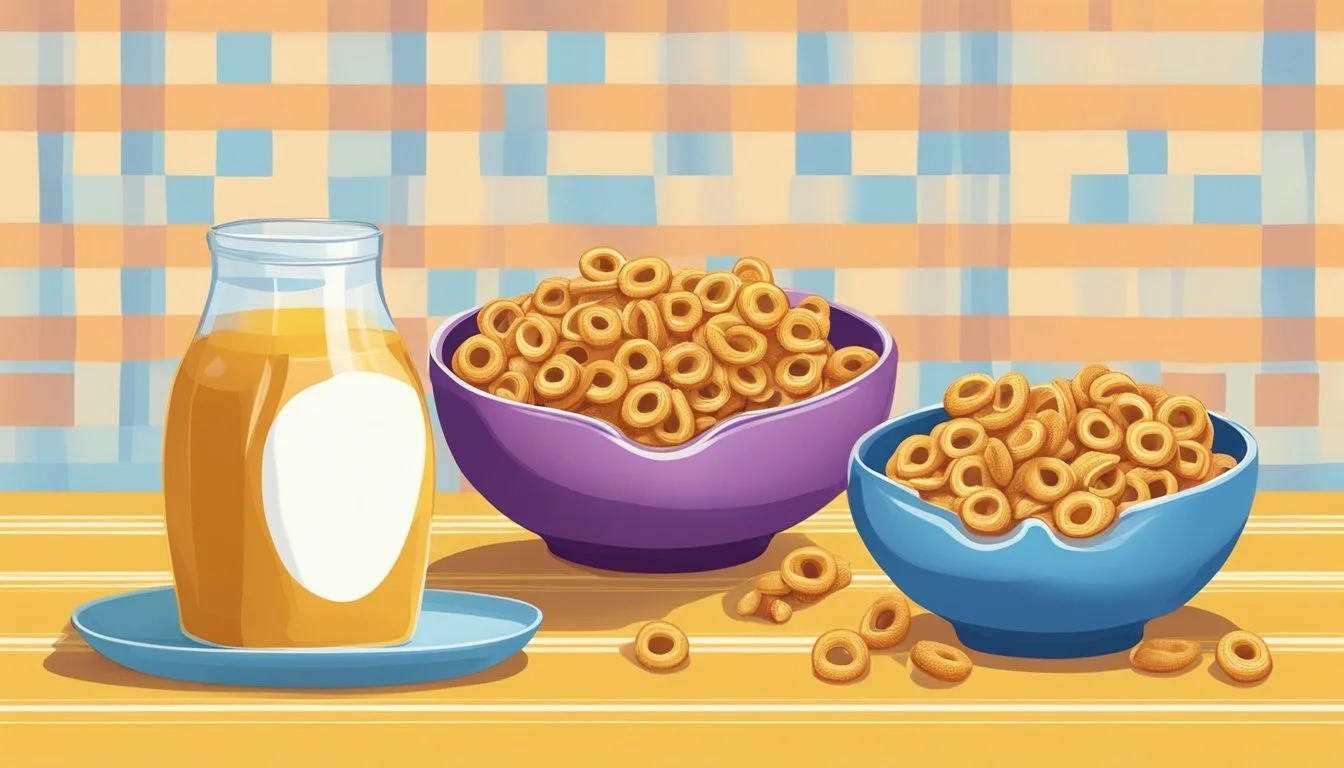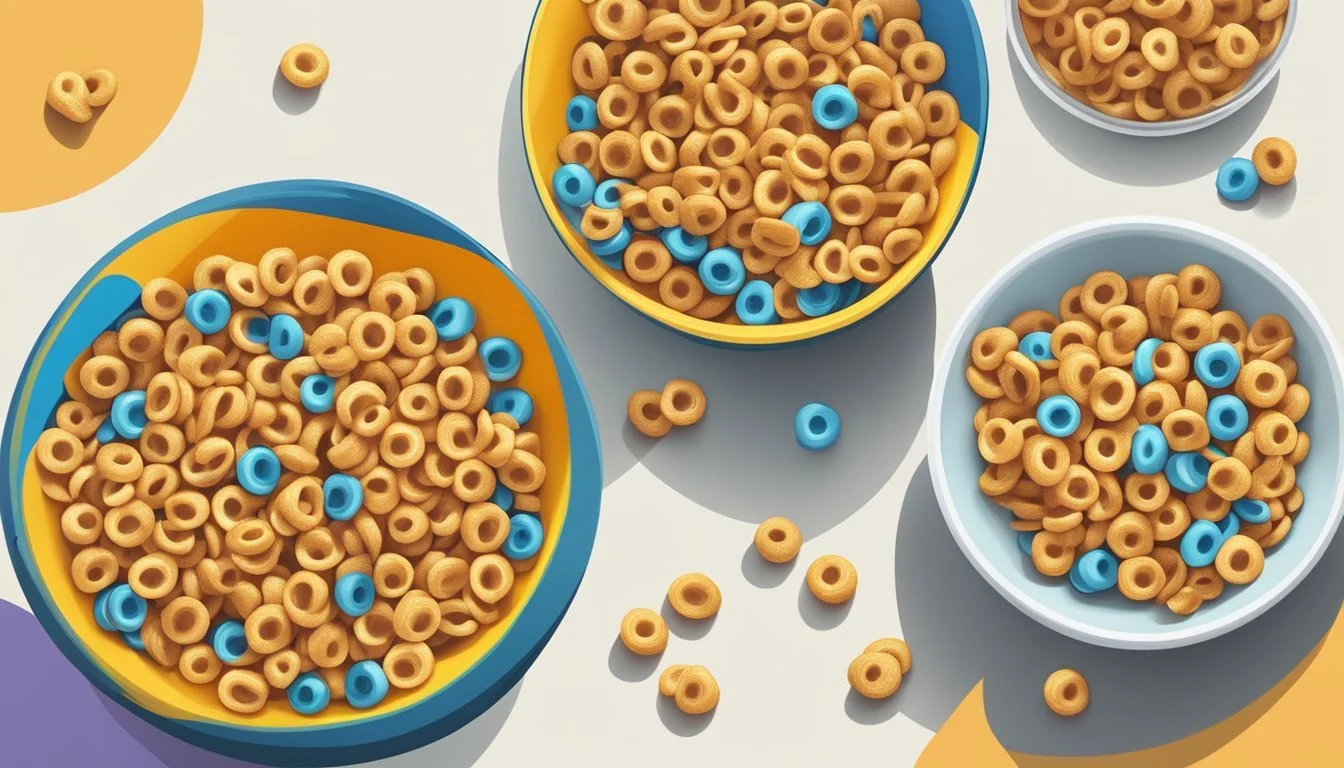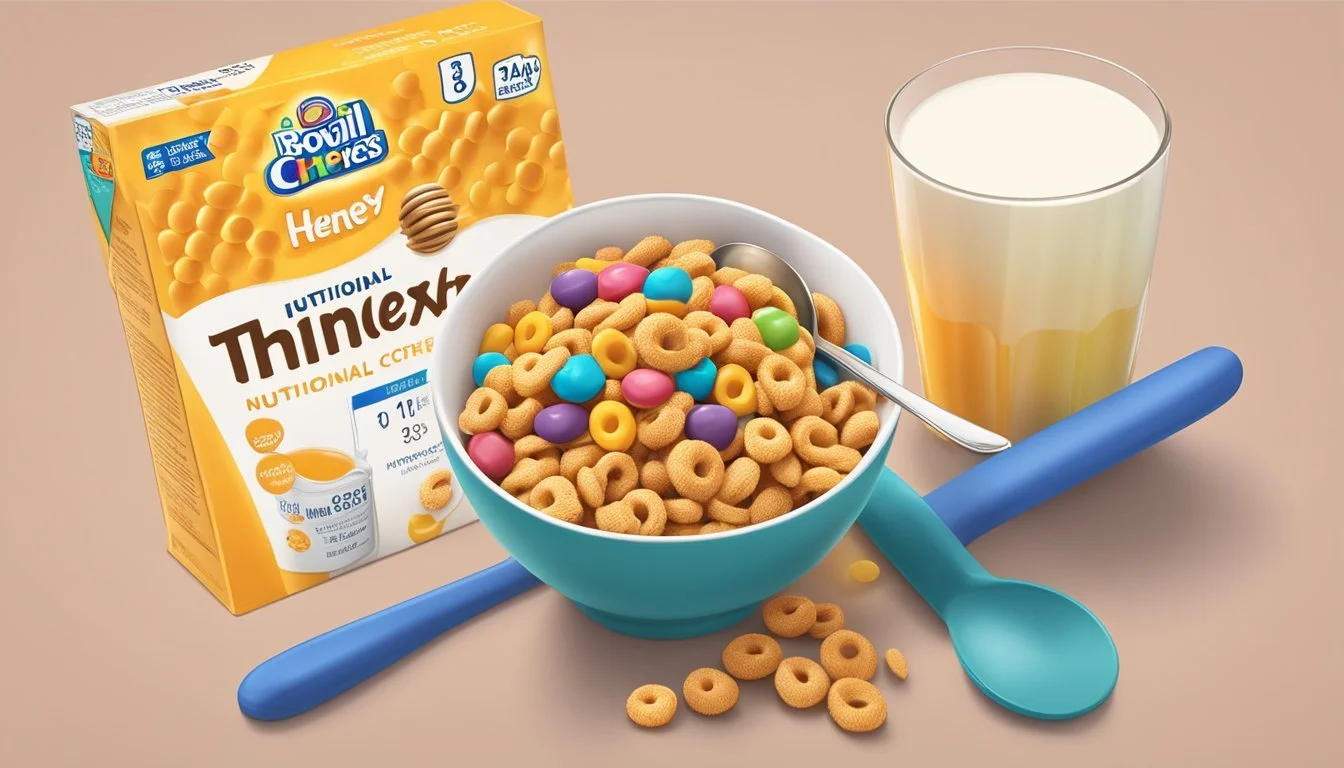Honey Nut Cheerios vs Trix
Comparing Breakfast Cereal Nutrition and Taste
This Article is Part of Our Breakfast Cereal Guide with Details on Honey Nut Cheerios Nutrition and Trix Nutrition
When choosing between Honey Nut Cheerios and Trix, it's essential to consider the nutritional content and dietary needs. Honey Nut Cheerios, produced by General Mills, offers a blend of complex carbohydrates and a touch of honey sweetness. Per serving, Honey Nut Cheerios contains 140 calories, 2 grams of fat, 30 grams of carbs, and 12 grams of sugar, making it a sweet yet relatively balanced option.
Trix, another popular cereal from General Mills, provides a vibrant, fruity flavor that appeals to children and adults alike. It contains 13 grams of complex carbohydrates per serving, which is slightly higher than that in Honey Nut Cheerios. However, it's crucial to note that Honey Nut Cheerios has more fiber per serving, which can aid in digestion and satiety.
For those conscious about sugar intake, Honey Nut Cheerios may not be the best choice as it contains more sugar compared to Trix. Selecting between the two ultimately depends on individual taste preferences and nutritional priorities.
History and Brand Overview
Honey Nut Cheerios and Trix are two iconic breakfast cereals produced by General Mills, each with its own unique origin story and evolution. Their histories reflect changes in consumer tastes and advancements in cereal production.
Origins of Honey Nut Cheerios
Honey Nut Cheerios was introduced in 1979 as a sweeter variation of the classic Cheerios.
Yandel Gonzalez spearheaded its creation, aiming to offer a new flavor experience. Initially, the cereal contained real nuts, specifically ground almonds, which contributed to its unique taste.
The use of nuts continued until 2006, when the recipe was altered to use natural almond flavor instead. This change was partly driven by the increasing awareness of nut allergies.
Today, Honey Nut Cheerios remains a popular choice, praised for its balance of honey flavor and nutritional benefits.
The Evolution of Trix
Trix made its debut in 1954 as a fruit-flavored cereal. It was one of the first cereals to use fruit shapes rather than traditional flakes or puffs, making it visually appealing.
Initially, the cereal featured three colors and flavors, but over the decades, additional colors and flavors were introduced.
The famous Trix Rabbit, introduced in 1959, became a cultural icon and a staple in the brand's advertising.
In recent years, General Mills has made attempts to align Trix with healthier eating trends, such as removing artificial colors and flavors. Despite these changes, Trix remains known for its vibrant appearance and playful marketing.
Comparative Analysis
Honey Nut Cheerios and Trix offer distinct experiences for cereal enthusiasts. Here, the focus is on their flavor profiles and their texture and appearance.
Flavor Profiles
Honey Nut Cheerios provide a blend of honey and almond flavors, resulting in a mildly sweet and nutty taste. The honey notes are prominent but not overpowering, making them suitable for both children and adults. On the other hand, Trix is known for its fruity flavor, featuring a variety of artificial fruit flavors.
While both cereals have a sweet profile, Honey Nut Cheerios are slightly less sugary compared to Trix, appealing to those who prefer a more subdued sweetness. The flavor differences are crucial for consumers, as Honey Nut Cheerios tend to be more versatile.
Texture and Appearance Comparison
Honey Nut Cheerios are round and O-shaped, maintaining a consistent crunch that holds up well even in milk. Their toasted exterior provides a satisfying bite without becoming too soggy quickly. The cereal pieces are uniform and have a light brown hue due to the honey glaze.
In contrast, Trix features brightly colored, fruit-shaped pieces, each representing a different flavor in the cereal. Their texture is slightly puffier and more porous compared to Honey Nut Cheerios, which can lead to quicker sogginess when immersed in milk. This vibrant appearance appeals more to children, making Trix a visual treat as well as a flavorful one.
Nutritional Content
This section provides a comparison of Honey Nut Cheerios and Trix based on key nutritional factors such as calories, macronutrients, fiber, vitamins, and minerals.
Caloric Values and Serving Sizes
Honey Nut Cheerios:
Serving Size: 1 cup (37g)
Calories per Serving: 140
Trix:
Serving Size: 1 cup (32g)
Calories per Serving: 120
Although Honey Nut Cheerios has a slightly larger serving size, it contains more calories per serving compared to Trix. Consumers need to consider serving size consistency to make accurate comparisons.
Macronutrients and Fiber Content
Honey Nut Cheerios (per serving):
Protein: 2g
Total Fat: 1.5g
Saturated Fat: 0g
Trans Fat: 0g
Polyunsaturated Fat: 0.5g
Monounsaturated Fat: 0.5g
Total Carbohydrate: 30g
Dietary Fiber: 3g
Total Sugars: 12g
Trix (per serving):
Protein: 1g
Total Fat: 1g
Saturated Fat: 0g
Trans Fat: 0g
Polyunsaturated Fat: 0.5g
Monounsaturated Fat: 0.3g
Total Carbohydrate: 24g
Dietary Fiber: 1g
Total Sugars: 11g
Honey Nut Cheerios has higher fiber content but also more sugars compared to Trix. Trix is lower in carbohydrates and provides slightly less fiber.
Vitamins and Minerals
Honey Nut Cheerios (per serving):
Iron: 70% DV
Calcium: 10% DV
Potassium: 2% DV
Vitamin D: 10% DV
Vitamin C: Not listed
Vitamin B6: 10% DV
Vitamin A: 10% DV
Folic Acid: 50% DV
Vitamin B12: 25% DV
Trix (per serving):
Iron: 25% DV
Calcium: 10% DV
Potassium: 30mg (less than 1% DV)
Vitamin D: 10% DV
Vitamin C: 10% DV
Vitamin B6: 10% DV
Vitamin A: 10% DV
Folic Acid: 25% DV
Vitamin B12: 10% DV
Honey Nut Cheerios is significantly higher in iron and folic acid, making it more beneficial for those needing these nutrients. Trix provides a decent amount of other essential vitamins but falls short in iron and folic acid content.
Consumer Preferences and Trends
Market data and health considerations play crucial roles in shaping preferences for Honey Nut Cheerios and Trix among consumers. Both cereals offer distinct flavors and nutritional profiles that appeal to different segments of the breakfast market.
Market Popularity and Sales Data
Honey Nut Cheerios and Trix cater to different taste preferences. Honey Nut Cheerios enjoy increased popularity due to their sweet honey flavor combined with the classic oat base. They saw a 41.84% change in popularity over the past year and are consumed an average of 1.08 times per year.
Honey Nut Cheerios also have a market adoption rate of 0.97% in restaurants and are priced at $5.83 on average. Trix, known for its colorful and fruity taste, tends to appeal more to children and is favored for its playful appearance and sweetness. Both brands are manufactured by General Mills, providing them significant visibility in the market.
Health and Diet Considerations
When comparing the nutritional aspects, Honey Nut Cheerios contain 11.5 grams of complex carbohydrates per serving, while Trix have 13.0 grams. The sugar content is a notable factor; Honey Nut Cheerios have higher sugars pert serving compared to Trix, but provide a balance with their complex carbs.
Consumers seeking healthier breakfast options might favor Honey Nut Cheerios for their reduced sugar content compared to other sweet cereals. They offer an enjoyable taste while maintaining a better nutritional profile. Trix, though higher in sugar, remain a popular choice for their taste and appeal to kids, making them more of a sweet treat rather than a diet-conscious choice.
Product Variations and Availability
Honey Nut Cheerios and Trix both offer a range of product variants and numerous purchasing options, giving consumers flexibility in choosing their preferred breakfast cereal experience.
Different Flavors and Editions
Honey Nut Cheerios is available in several editions beyond the classic version. Consumers can find options such as Chocolate Peanut Butter Cheerios, Fruity Cheerios, and Chocolate Cheerios. Each variant offers a unique flavor profile while maintaining the nutritional benefits that Cheerios is known for.
Trix, known for its bright, fruity flavors, primarily sticks to its original taste. Occasionally, special editions or limited-time releases are available, adding a twist to the familiar Trix experience.
These variations cater to diverse taste preferences and nutritional needs, from richer chocolatey tastes to fruity options that appeal especially to children.
Retail and Online Purchase Options
Both Honey Nut Cheerios and Trix are readily available at major retail stores such as Walmart and Target, which often carry a wide range of flavors and editions. This ensures that customers can easily find their favorite cereals or try new variations.
Additionally, these products are available through various online platforms. Retailer websites, Amazon, and direct purchases from the General Mills website provide consumers convenient access.
Many grocery delivery services also carry Honey Nut Cheerios and Trix, further simplifying the purchasing process for those who prefer doorstep delivery. This extensive availability ensures that regardless of location, consumers can enjoy their favorite cereals.
Marketing and Advertising Strategies
This section delves into the marketing and advertising strategies employed by Honey Nut Cheerios and Trix, focusing on their brand messaging, target audience, and comparative advertising tactics.
Brand Messaging and Target Audience
Honey Nut Cheerios, produced by General Mills, has positioned itself as a wholesome and heart-healthy cereal, often highlighting its use of whole grain oats and its low sugar content.
Their campaigns frequently feature themes of health and family, aiming to appeal to parents seeking nutritious options for their children.
Trix, also a General Mills product, adopts a more playful and colorful approach.
Their messaging leans heavily on the cereal's vibrant colors and fruity flavors. The target audience for Trix skews younger, aiming to attract children with fun and excitement, often using cartoon characters in their advertisements.
Both brands strategically use social media influencers to reach their audiences, with Honey Nut Cheerios focusing on lifestyle and health influencers, while Trix targets influencers who appeal to a younger demographic.
Comparative Advertising Tactics
In comparative advertising, Honey Nut Cheerios and Trix often emphasize their unique selling points to differentiate themselves in the crowded cereal market.
Honey Nut Cheerios advertises its health benefits, prominently showcasing nutritional information and heart health claims. This is often contrasted with cereals perceived as less healthy, making it an attractive choice for health-conscious consumers.
On the other hand, Trix focuses on brand identity and excitement. Their advertising is visually stimulating, highlighting the bright colors and fun shapes.
Campaigns often incorporate interactive elements like games and contests, aimed at directly engaging their young audience.
By comparing their offerings against other cereals, Trix stresses the "fun" aspect, distinguishing it from more health-focused brands like Honey Nut Cheerios.
These strategic approaches allow both brands to maintain distinct identities while appealing to their respective target audiences.
More on Honey Nut Cheerios
Cinnamon Toast Crunch vs Honey Nut Cheerios: Which is better?
Honey Nut Cheerios vs Kellogg's Apple Jacks: Which is better?
Honey Nut Cheerios vs Kellogg's Froot Loops: Which is better?
Honey Nut Cheerios vs Post GrapevsNut Flakes: Which is better?
Honey Nut Cheerios vs Post Raisin Bran Cereal: Which is better?





